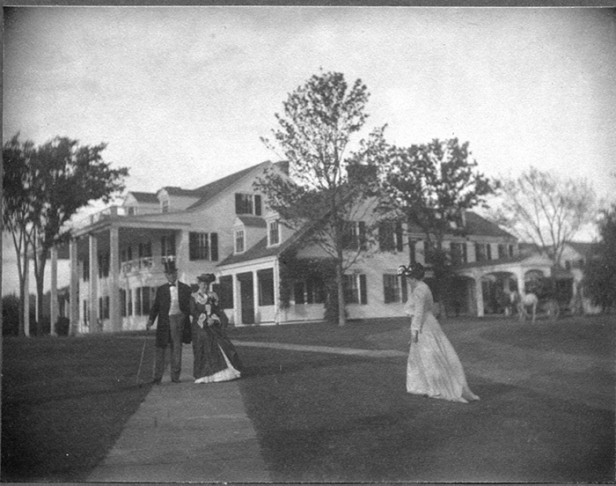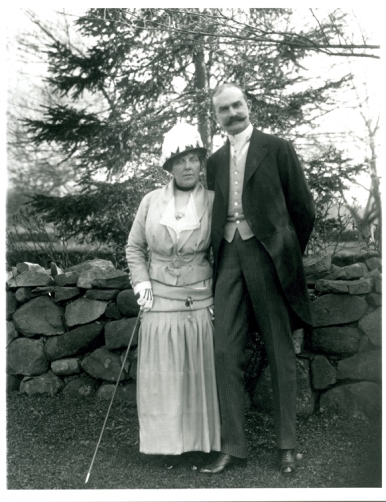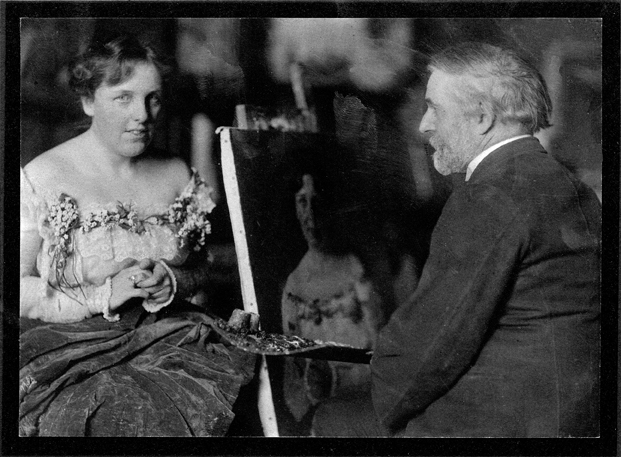By Nancy Finlay
She was not originally called Theodate. Her parents named her Effie Brooks Pope, but when she was 19, she chose the name Theodate, after a much-admired grandmother. She insisted on being called Theodate ever afterwards. Her choice of name reflected a desire to control her own destiny and shape her own life. For a young woman coming of age in the late 19th century, this was revolutionary.
Effie “Theodate” Pope was born in Ohio in 1867. Her father, Alfred Pope, was a self-made millionaire and a serious art collector who doted on his headstrong, determined daughter. Theodate attended Miss Mittelberger’s School for Girls in Cleveland, followed by two years at Miss Porter’s School in Farmington, Connecticut. Despite not being a good student, she enjoyed her time at Miss Porter’s, fell in love with Farmington, and decided to make it her permanent home. She rented—and later bought—a small house on High Street, where she ran a farm and a small shop while trying to figure out what to do with the rest of her life.
She considered a career as a writer or an artist; but finally decided that her true calling was architecture. She did not attend college and had no formal training as an architect, although by the end of the 19th century, architectural programs at the Massachusetts Institute of Technology and the Ecole des Beaux Arts in Paris admitted women. She learned about the history of architecture during trips to Europe with her family, from her extensive reading, and in the course of a short period of study with Allan Marquand, the founder of the Department of Art and Archaeology at Princeton University.

Gertrude Käsebier photo, of Ada, Alfred and Theodate Pope on their West Lawn walkway, ca. 1902 – Hill-Stead Museum
Building Hill-Stead
Strong-willed and forceful, Pope convinced her parents to retire to Farmington, purchasing 250 acres adjoining her property on High Street. Her father engaged the prestigious New York architectural firm McKim, Mead & White to design his new house and invited his daughter to participate in the project. Theodate quickly seized control, insisting that Hill-Stead should be a “Pope house,” not a McKim, Mead & White house. She envisioned a rambling Connecticut farmhouse, with strong colonial revival elements and a monumental portico recalling Washington’s Mount Vernon. She relied on professional draftsmen to give form to her ideas, but she oversaw every stage of the design process. Critics hailed Hill-Stead (completed in 1906) as a masterpiece. Early publications credited it to McKim, Mead & White, but it is now recognized as the work of Theodate Pope Riddle. Following the deaths of her parents, the house became Theodate’s own home.
Pope went on to design other Connecticut landmarks, such as the Westover School in Middlebury, Connecticut (1909), the Hop Brook School in Naugatuck, Connecticut (1915), and several private houses. She established an office in a small building on the Hill-Stead estate with a sign on the door reading “Theodate Pope, Architect.” Although licensed as an architect in New York as early as 1916 and elected to the American Institute of Architects in 1918, she did not get a license to officially work in Connecticut until 1933.
Among her most prestigious early accomplishments was earning a commission to reconstruct Theodore Roosevelt’s boyhood home in New York City. Commissions for an untrained woman architect, however, remained few and far between, and depended mostly on personal connections (despite Pope’s unmistakable talent).

At the age of 49, Theodate Pope married diplomat John Wallace Riddle; this is a photograph from their wedding day, May 6, 1916 – Hill-Stead Museum
In 1916 (one year after surviving passage on the ill-fated liner Lusitania), Pope astonished her family and friends by agreeing to marry John Wallace Riddle, a charming former diplomat who courted her for years. Contrary to expectations, the marriage proved a happy one. Riddle supported Theodate’s architectural aspirations and encouraged her in her final significant project, the creation of Avon Old Farms School. Theodate conceived of the school as a memorial to her father. She purchased nearly three thousand acres in Avon, and in a sudden flash of inspiration, laid out the basic design for the campus and its buildings in an architectural style inspired by the British Arts and Crafts movement and the vernacular architecture of the Cotswolds in England. She hired English craftsmen and insisted on the use of traditional hand tools and construction methods. Work began in 1918, but went on for years, with Theodate overseeing every detail. The school finally opened in 1927 with Pope contributing not only to its architecture, but also to its curriculum.
Theodate Pope Riddle Prospers in a Male-Dominated Profession
Early in her career Theodate Pope submitted a photograph of herself for inclusion in a publication on prominent architects and their work. When the publication’s editors saw the photograph and realized that she was a woman, they opted not to include her in the book. Her career was a long struggle against prejudice. At the time of her death in 1946, she was just beginning to receive proper recognition for her work as an architect, but enthusiasm for modern architecture was at its height and critics frequently dismissed her work as old-fashioned. Pope herself had little patience with modern architecture. She regarded it as a failure, as “purely intellectual, without regard to the emotions.” Pope lamented, “Men who work with machinery during the day might rather not sleep in a machine at night.” Today, in the post-modern period, many authorities agree with her.
Her legacy is one of a pioneering woman architect, whose buildings withstand the test of time and remain as fine as the work of any of her contemporary male colleagues. The home she designed for her parents remains open to the public as a museum—a showcase for the world-class collection of impressionist paintings assembled by Theodate’s father.
Nancy Finlay grew up in Manchester, Connecticut. She has a BA from Smith College and an MFA and PhD from Princeton University. From 1998 to 2015, she was Curator of Graphics at the Connecticut Historical Society.









